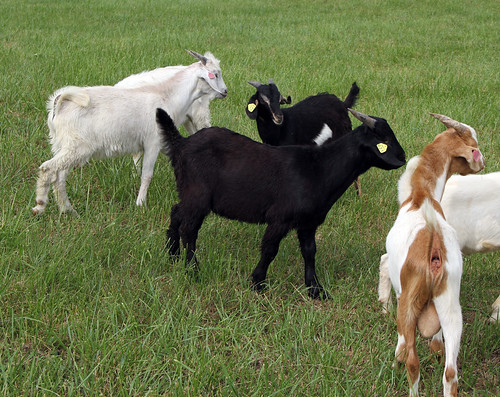The first pooled fecal sample was collected on June 3-4 from random goats from each consigner. The pooled sample was sent via overnite mail to Dr. Ray Kaplan's lab at the University of Georgia College of Veterinary Medicine-Department of Infectious Diseases.
The pooled fecal egg count was 350 epg, less than the average fecal egg count from the individual goats (734 epg). The eggs were hatched so that the strongyle-type worms could be identified from the larvae.
Eighty-one percent (81) of the strongyle-type eggs in the pooled sample were Haemonchus contortus. Nineteen (19) percent of the eggs were Trichostrongylus.
The common name for Haemonchus contortus is the barber pole worm. In other countries, it is sometimes called the wire worm or large stomach worm. The barber pole worm is a blood-sucking parasite that causes anemia (blood and protein loss) and bottle jaw (edema). Left unchecked, it can quickly kill young goats.
The female barber pole worm is a prolific egg layer. 2,000 eggs per gram is considered clinically significant, though clinical parasitism may occur at lower levels, under certain circumstances and among certain animals.
Trichostrongylus spp. is in the same genus as the barber pole worm, but it is less deadly. Light infections may result in unthriftiness and dagginess (scours). High levels of infections can result in rapid weight loss, dehydration, and death.
Trichostrongylus is more often part of a mixed parasitic infection. The level at which egg counts are considered clinically significant may be less than 500 epg, as the worm is not nearly as prolific as its cousin, the barber pole worm.
The pooled sample contained a moderate amount (3+) of coccidia oocytes. Tricuris (whipworm) eggs were also identified in the pooled sample. The goats were treated for coccidiosis during the first five days of the test. Their mineral mix contains a coccidiostat (Rumensin©).
Coccidia oocyte counts are of limited value. This is because not all coccidia are pathogenic or have the sample level of pathogenicity. In addition, a goat may become clinically parasitized before shedding any oocytes. Diagnosis of coccidiosis should be based primarily upon clinical signs and history.
Read article about coccidiosis
The pooled fecal egg count was 350 epg, less than the average fecal egg count from the individual goats (734 epg). The eggs were hatched so that the strongyle-type worms could be identified from the larvae.
 |
| A few of the bucks |
Eighty-one percent (81) of the strongyle-type eggs in the pooled sample were Haemonchus contortus. Nineteen (19) percent of the eggs were Trichostrongylus.
The common name for Haemonchus contortus is the barber pole worm. In other countries, it is sometimes called the wire worm or large stomach worm. The barber pole worm is a blood-sucking parasite that causes anemia (blood and protein loss) and bottle jaw (edema). Left unchecked, it can quickly kill young goats.
The female barber pole worm is a prolific egg layer. 2,000 eggs per gram is considered clinically significant, though clinical parasitism may occur at lower levels, under certain circumstances and among certain animals.
Trichostrongylus spp. is in the same genus as the barber pole worm, but it is less deadly. Light infections may result in unthriftiness and dagginess (scours). High levels of infections can result in rapid weight loss, dehydration, and death.
Trichostrongylus is more often part of a mixed parasitic infection. The level at which egg counts are considered clinically significant may be less than 500 epg, as the worm is not nearly as prolific as its cousin, the barber pole worm.
 |
| Taking a rest |
The pooled sample contained a moderate amount (3+) of coccidia oocytes. Tricuris (whipworm) eggs were also identified in the pooled sample. The goats were treated for coccidiosis during the first five days of the test. Their mineral mix contains a coccidiostat (Rumensin©).
Coccidia oocyte counts are of limited value. This is because not all coccidia are pathogenic or have the sample level of pathogenicity. In addition, a goat may become clinically parasitized before shedding any oocytes. Diagnosis of coccidiosis should be based primarily upon clinical signs and history.
Read article about coccidiosis











